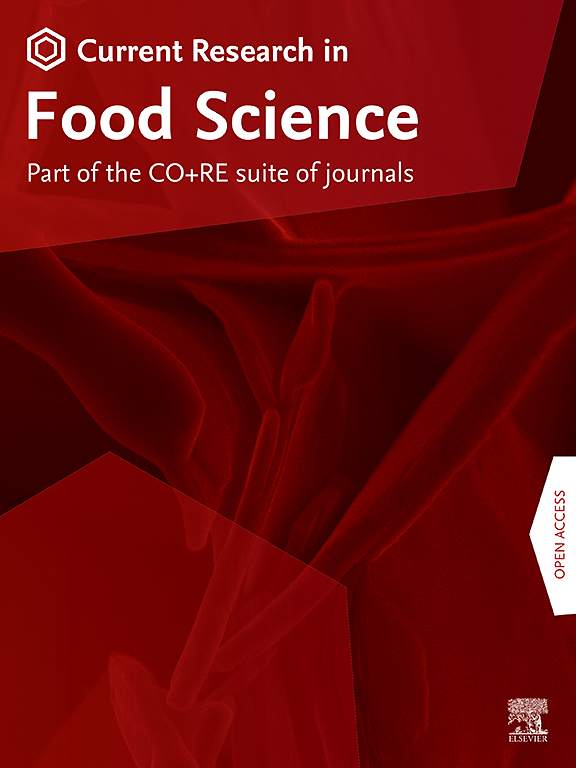Fermented beetroot modulates gut microbial carbohydrate metabolism in prediabetes and prevents high-fat diet induced hyperglycemia in a prediabetic model
IF 6.2
2区 农林科学
Q1 FOOD SCIENCE & TECHNOLOGY
引用次数: 0
Abstract
The global increase in prevalence of (pre-)diabetes demands immediate intervention strategies. In our earlier work, we demonstrated in vitro antidiabetic potential of a fermented beetroot product (PN39). Here, we examined the impact of PN39 on glucose tolerance and gut microbiota in C57BL/6J male mice and on prediabetic (PD) subjects’ stool microbiota. In mice, high-fat diet (HFD) consumption for 9 weeks resulted in hyperglycemia and impaired glucose tolerance (GT) while concomitant consumption of PN39 and HFD (PN39+HFD) prevented GT impairment. Meanwhile, feeding the mice with HFD for 5 weeks to induce PD and later administering them with PN39 for 4 weeks (PD + PN39) neither improved fasting blood glucose nor GT. Relative to control groups, the gut microbiota of both PD mice and humans were characterized by decreased Clostridia UCG-014 and Lactobacilli as well as significantly altered gut microbial carbohydrate metabolism. Feeding PN39 together with HFD preserved Clostridia UCG-014 and Lactobacilli, increased short chain fatty acid production relative to mice fed with HFD only. Treating gut microbiota of PD subjects with PN39 however increased Clostridia UCG-014 and Lactobacilli populations and increased short chain fatty acids concentrations in the stools. In both mice and humans, PN39 treatment rectified the altered microbial carbohydrate metabolism observed in their PD counterparts. This suggests that the gut microbial modulatory effects of PN39 coupled with its capacity to regulate gut microbial glucose metabolism, likely played a role in preventing PD in mice receiving PN39+HFD. Taken together, our results indicate that PN39 could act as a potent antidiabetic functional food for preventing diabetes and its associated dysbiosis.

在糖尿病前期模型中,发酵甜菜根调节糖尿病前期肠道微生物碳水化合物代谢并防止高脂肪饮食引起的高血糖
全球(前期)糖尿病患病率的增加需要立即采取干预策略。在我们早期的工作中,我们证明了发酵甜菜根产品(PN39)的体外抗糖尿病潜力。在这里,我们研究了PN39对C57BL/6J雄性小鼠葡萄糖耐量和肠道微生物群的影响,以及对糖尿病前期(PD)受试者粪便微生物群的影响。在小鼠中,连续9周食用高脂饮食(HFD)导致高血糖和葡萄糖耐量(GT)受损,而同时食用PN39和HFD (PN39+HFD)可防止GT损伤。同时,用HFD诱导PD小鼠5周,再用PN39 (PD + PN39)诱导PD小鼠4周,均未改善空腹血糖和GT。与对照组相比,PD小鼠和人的肠道微生物群均减少了梭菌UCG-014和乳酸杆菌,肠道微生物碳水化合物代谢显著改变。PN39与HFD保存的梭状芽孢杆菌UCG-014和乳酸菌一起饲喂,与仅饲喂HFD相比,短链脂肪酸产量增加。然而,用PN39治疗PD患者的肠道微生物群会增加梭状芽孢杆菌UCG-014和乳酸杆菌的数量,并增加粪便中的短链脂肪酸浓度。在小鼠和人类中,PN39治疗纠正了PD中观察到的微生物碳水化合物代谢的改变。这表明PN39的肠道微生物调节作用及其调节肠道微生物葡萄糖代谢的能力可能在PN39+HFD小鼠中预防PD中发挥作用。综上所述,我们的研究结果表明,PN39可以作为一种有效的抗糖尿病功能食品,预防糖尿病及其相关的生态失调。
本文章由计算机程序翻译,如有差异,请以英文原文为准。
求助全文
约1分钟内获得全文
求助全文
来源期刊

Current Research in Food Science
Agricultural and Biological Sciences-Food Science
CiteScore
7.40
自引率
3.20%
发文量
232
审稿时长
84 days
期刊介绍:
Current Research in Food Science is an international peer-reviewed journal dedicated to advancing the breadth of knowledge in the field of food science. It serves as a platform for publishing original research articles and short communications that encompass a wide array of topics, including food chemistry, physics, microbiology, nutrition, nutraceuticals, process and package engineering, materials science, food sustainability, and food security. By covering these diverse areas, the journal aims to provide a comprehensive source of the latest scientific findings and technological advancements that are shaping the future of the food industry. The journal's scope is designed to address the multidisciplinary nature of food science, reflecting its commitment to promoting innovation and ensuring the safety and quality of the food supply.
 求助内容:
求助内容: 应助结果提醒方式:
应助结果提醒方式:


